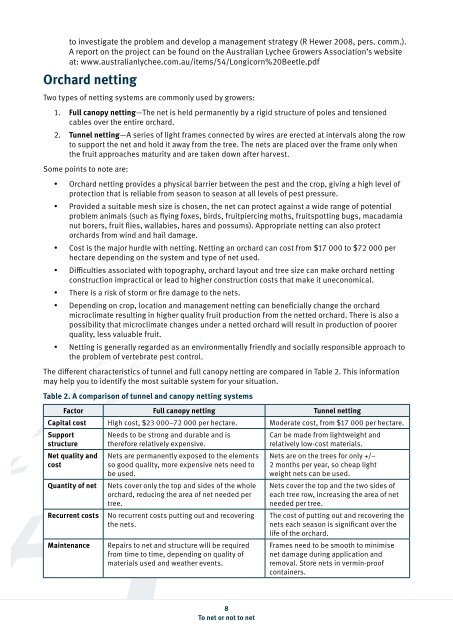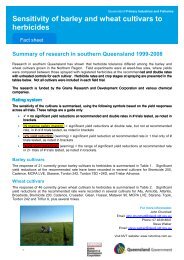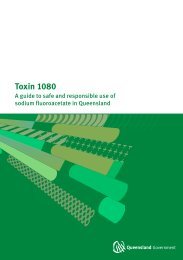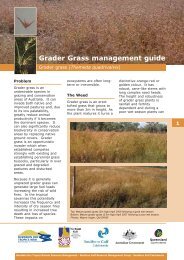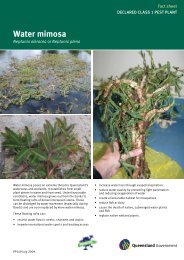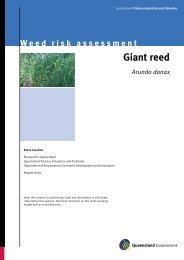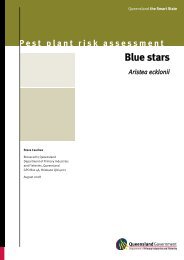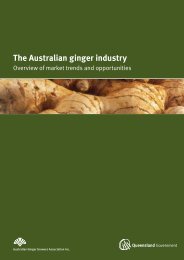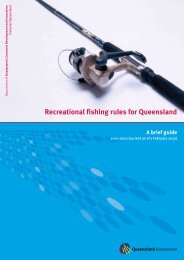To net or not to net - 3rd edition - Department of Primary Industries
To net or not to net - 3rd edition - Department of Primary Industries
To net or not to net - 3rd edition - Department of Primary Industries
Create successful ePaper yourself
Turn your PDF publications into a flip-book with our unique Google optimized e-Paper software.
<strong>to</strong> investigate the problem and develop a management strategy (R Hewer 2008, pers. comm.).<br />
A rep<strong>or</strong>t on the project can be found on the Australian Lychee Growers Association’s website<br />
at: www.australianlychee.com.au/items/54/Longic<strong>or</strong>n%20Beetle.pdf<br />
Orchard <strong>net</strong>ting<br />
Two types <strong>of</strong> <strong>net</strong>ting systems are commonly used by growers:<br />
1. Full canopy <strong>net</strong>ting—The <strong>net</strong> is held permanently by a rigid structure <strong>of</strong> poles and tensioned<br />
cables over the entire <strong>or</strong>chard.<br />
2. Tunnel <strong>net</strong>ting—A series <strong>of</strong> light frames connected by wires are erected at intervals along the row<br />
<strong>to</strong> supp<strong>or</strong>t the <strong>net</strong> and hold it away from the tree. The <strong>net</strong>s are placed over the frame only when<br />
the fruit approaches maturity and are taken down after harvest.<br />
Some points <strong>to</strong> <strong>not</strong>e are:<br />
•<br />
•<br />
•<br />
•<br />
•<br />
•<br />
•<br />
Orchard <strong>net</strong>ting provides a physical barrier between the pest and the crop, giving a high level <strong>of</strong><br />
protection that is reliable from season <strong>to</strong> season at all levels <strong>of</strong> pest pressure.<br />
Provided a suitable mesh size is chosen, the <strong>net</strong> can protect against a wide range <strong>of</strong> potential<br />
problem animals (such as flying foxes, birds, fruitpiercing moths, fruitspotting bugs, macadamia<br />
nut b<strong>or</strong>ers, fruit flies, wallabies, hares and possums). Appropriate <strong>net</strong>ting can also protect<br />
<strong>or</strong>chards from wind and hail damage.<br />
Cost is the maj<strong>or</strong> hurdle with <strong>net</strong>ting. Netting an <strong>or</strong>chard can cost from $17 000 <strong>to</strong> $72 000 per<br />
hectare depending on the system and type <strong>of</strong> <strong>net</strong> used.<br />
Difficulties associated with <strong>to</strong>pography, <strong>or</strong>chard layout and tree size can make <strong>or</strong>chard <strong>net</strong>ting<br />
construction impractical <strong>or</strong> lead <strong>to</strong> higher construction costs that make it uneconomical.<br />
There is a risk <strong>of</strong> st<strong>or</strong>m <strong>or</strong> fire damage <strong>to</strong> the <strong>net</strong>s.<br />
Depending on crop, location and management <strong>net</strong>ting can beneficially change the <strong>or</strong>chard<br />
microclimate resulting in higher quality fruit production from the <strong>net</strong>ted <strong>or</strong>chard. There is also a<br />
possibility that microclimate changes under a <strong>net</strong>ted <strong>or</strong>chard will result in production <strong>of</strong> po<strong>or</strong>er<br />
quality, less valuable fruit.<br />
Netting is generally regarded as an environmentally friendly and socially responsible approach <strong>to</strong><br />
the problem <strong>of</strong> vertebrate pest control.<br />
The different characteristics <strong>of</strong> tunnel and full canopy <strong>net</strong>ting are compared in Table 2. This inf<strong>or</strong>mation<br />
may help you <strong>to</strong> identify the most suitable system f<strong>or</strong> your situation.<br />
Table 2. A comparison <strong>of</strong> tunnel and canopy <strong>net</strong>ting systems<br />
Fact<strong>or</strong> Full canopy <strong>net</strong>ting Tunnel <strong>net</strong>ting<br />
Capital cost High cost, $23 000–72 000 per hectare. Moderate cost, from $17 000 per hectare.<br />
Supp<strong>or</strong>t<br />
structure<br />
Net quality and<br />
cost<br />
Needs <strong>to</strong> be strong and durable and is<br />
theref<strong>or</strong>e relatively expensive.<br />
Nets are permanently exposed <strong>to</strong> the elements<br />
so good quality, m<strong>or</strong>e expensive <strong>net</strong>s need <strong>to</strong><br />
be used.<br />
Quantity <strong>of</strong> <strong>net</strong> Nets cover only the <strong>to</strong>p and sides <strong>of</strong> the whole<br />
<strong>or</strong>chard, reducing the area <strong>of</strong> <strong>net</strong> needed per<br />
tree.<br />
Recurrent costs No recurrent costs putting out and recovering<br />
the <strong>net</strong>s.<br />
Maintenance Repairs <strong>to</strong> <strong>net</strong> and structure will be required<br />
from time <strong>to</strong> time, depending on quality <strong>of</strong><br />
materials used and weather events.<br />
8<br />
<strong>To</strong> <strong>net</strong> <strong>or</strong> <strong>not</strong> <strong>to</strong> <strong>net</strong><br />
Can be made from lightweight and<br />
relatively low-cost materials.<br />
Nets are on the trees f<strong>or</strong> only +/–<br />
2 months per year, so cheap light<br />
weight <strong>net</strong>s can be used.<br />
Nets cover the <strong>to</strong>p and the two sides <strong>of</strong><br />
each tree row, increasing the area <strong>of</strong> <strong>net</strong><br />
needed per tree.<br />
The cost <strong>of</strong> putting out and recovering the<br />
<strong>net</strong>s each season is significant over the<br />
life <strong>of</strong> the <strong>or</strong>chard.<br />
Frames need <strong>to</strong> be smooth <strong>to</strong> minimise<br />
<strong>net</strong> damage during application and<br />
removal. St<strong>or</strong>e <strong>net</strong>s in vermin-pro<strong>of</strong><br />
containers.


